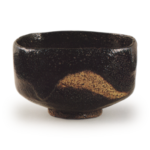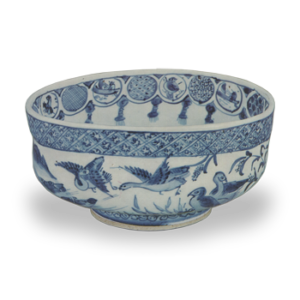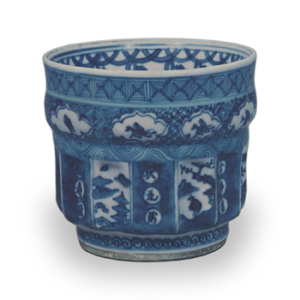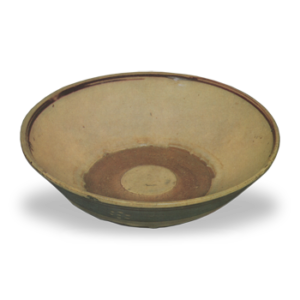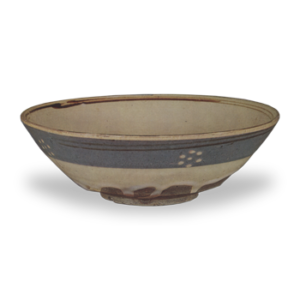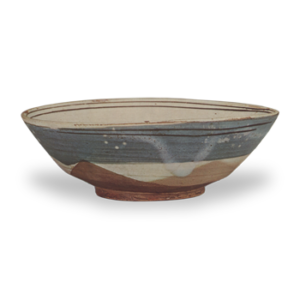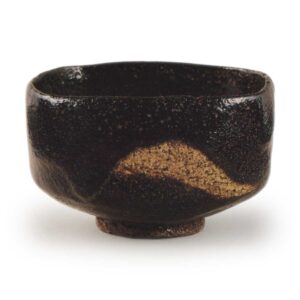
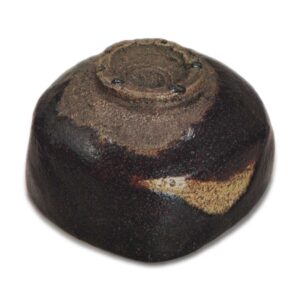
Height: 7.3cm
Diameter: 11.5-13.0cm
Foot diameter: 5.5-5.7cm
Height: 0.8cm
At some point, the seven bowls of Wakayama, Inazuma, Horin, Masu, Shishi, Chidori and Tsuru were selected and named the “Nanko Shichisai” after the “Chojiro Shichisai”, and are considered to be Nanko’s masterpieces, but the “Masu” bowl is particularly well known as the best of the group. Needless to say, the shape of the tea bowl is based on the fact that it is square on all sides, but it is also square on all sides.
As Hon’ami Koetsu praised Kichibei as “a master of the art of Raku”, all of Kichibei’s works are light and full of vitality, but this “Masu” tea bowl is a tea bowl that truly shows off Kichibei’s skills.
The features of Nokou’s black raku ware are the makuyu and hihakyu glazes, and this tea bowl fully displays both of these, and because the shape of the tea bowl is square, it seems to be of a higher quality than the Chidori.
The foot ring is smoothly carved, and the body is slightly plump, with a slight constriction in some places. The rim is almost completely hidden inside the bowl. Apart from the fact that the shape is square from the waist down, it is not an overly contrived shape, and can be said to be a very simple and ordinary tea bowl.
The rim is quite thin, and the inside is shaped like a clam shell. The inside is very spacious and relaxed. The way the bowl is made to curve widely without a tea-drip well is unique to Nōkō, and if you are looking for a similar shape, the closest match would be Koetsu’s, or perhaps something influenced by Koetsu. It could be said that the reason Nōkō’s tea bowls are the easiest of the Raku tea bowls to make tea in is due to the good curvature of the inside of the bowl.
The use of a foot ring and a foot ring rim that reveals the clay is seen in some of the tea bowls by Jōkei Zaiin, but it was Nonkō who really established this style, and it is thought that this was done in order to make the “raku” character seal pressed into the foot ring stand out clearly. In the case of this tea bowl in particular, the fact that the clay was left exposed in order to show the mark is understandable, as there is no hint of any decorative intent in the exposed clay. The fact that the black glaze is clearly attached to the five trivet-shaped areas on the foot ring can also be said to be one of the characteristics of Nongou clay tea bowls.
Apart from the white glaze applied in a mountain shape to one side of the body, the rest of the body is covered in black raku glaze, which is applied thinly around the waist and thickly from the rim to the body, creating a variation that looks like a hanging curtain. The glaze is thick and melts very well, giving it a jet-black sheen. In addition, the areas where the glaze is thin at the bottom have a tinge of amber.
As you can see, the glaze on this Nongou tea bowl was applied with decorative intent, but this kind of intentionality was completely absent from the Chojiro tea bowls favored by Rikyu, and it can be said that this was a product of the spirit of the times in the early Edo period.
The inner box is paulownia wood. On the underside of the lid, Kakuzai Hara So wrote “Black Noko Masu Tea Bowl (signature)”. It was originally owned by the Osaka merchant Ikiya, and later became the property of the Akaboshi family of Tokyo. In June 1917, at the first auction held by the Akaboshi family, it was sold to Ryokichi Isono of Osaka for the high price of 67,000 yen, causing a stir in the tea world.

